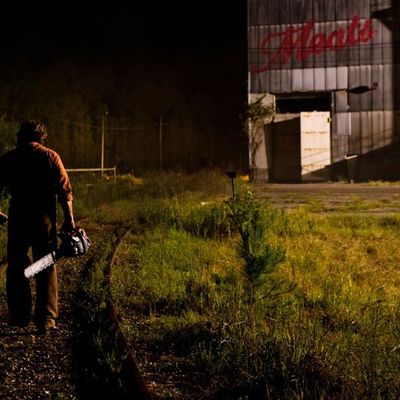
Full disclosure: I’m not the world’s biggest fan of Tobe Hooper’s original 1974 Texas Chain Saw Massacre, a film that’s admirable as a grindhouse provocation for meat-eating gorehounds but doesn’t quite hold up nowadays in terms of suspense or terror. (Hooper did way better work on that score with Poltergeist and The Funhouse.) But it obviously worked for millions of people, what with it being one of the seminal horror flicks of all time and effectively kickstarting the slasher genre and whatnot. And certain images from it still have a creepy resonance: the way Hooper’s camera dwelled on the bodies of the young cast, for example, a kind of metaphorical, visual cannibalism that echoed the actual cannibalism of the plot.
John Luessenhop’s new sequel starts things off smartly, with an opening-credits sequence composed of footage from the original film (now in 3-D). That footage fairly fluidly moves into the new movie, which posits that, in the immediate wake of the events of the original, Leatherface and his demented family were attacked at home by a mob of townspeople from Newt, Texas, who burned the place, along with the entire Sawyer clan, down. One member of the mob, however, took a baby from Leatherface’s young aunt before killing her and raised the child as his own.
Now that child, fully grown into the buxom Heather Miller (Alexandra Daddario), has just discovered that she had this other family and that they’ve left her an inheritance. Confused, the perpetually midriff-baring Heather decides to head down to Texas (with some friends, of course, among them her boyfriend, played by Trey Songz) to find out just who these people were and what they’ve left her. Turns out she’s inherited a giant, elegant farmhouse. The only sticking point is that Leatherface, her cousin, is still living in its basement, and he immediately starts cutting the youngsters into pieces.
The first half of the film is a lot of workmanlike, but ultimately fairly stupid, slasher-movie near-escapes. Luessenhop tries to invest some of his imagery with that same offhand physicality that Hooper brought to it, letting his attractive young cast (who as usual have a tendency to lose their shirts and/or pants) pose in suggestive ways that highlight the fact that the camera is turning them into meat long before the bad guy ever does. But that’s exactly how it all feels: posed. Subtlety is not an arrow to be used in the quiver of the modern-day horror reboot. Similarly, the original Massacre also had a reputation for being a lot more gory than it actually was; Luessenhop’s variation wants to correct that oversight and thus presents us with literal buckets of gore. This time, when someone is sliced in half with a chainsaw, we pretty much see it all. Not much is left to our imaginations.
The film’s thrills are generic, though sometimes surprisingly reliable: Leatherface’s sudden appearance somehow manages to seem matter-of-fact while also providing some decent jumps. And the predictable 3-D effect of the chainsaw slicing straight at us works better than you might expect. As does the cast: To be fair, of the younger actors, only Daddario gets to do anything more than scream and run and die, but she displays a level of commitment that’s sort of admirable.
The film takes an odd, almost political turn in its second half, as Heather begins to realize that the gun-lovin’, Bible-thumpin’ smalltown rubes who populate this town might be even more dangerous than the giant, chainsaw-wielding indestructible madman in the basement. As a result, the climax of Texas Chainsaw 3D is a bit more interesting and unpredictable than the usual horror-movie third act. But it feels like it’s bred more out of desperation than anything organic; you can sense the gears turning in the screenwriters’ heads as they try to figure out a way to breathe some fresh life into this franchise. It’s to their credit that they almost succeed. Texas Chainsaw 3D isn’t exactly good, but despite its many clichés and generic indulgences, you want to give it some points for trying.


